The Shared Transaction Repository
(STR) Accountant's explanation
|
Home |
Below is tutorial aimed at accountants and
bookkeepers, showing how shared data on the Internet can improve
accounting processes.
This is not an automatic reconciliation or
replication scheme. The STR is a true shared
database. It is a true shift from company-centric to
a single, shared, network-centric storage and transaction execution.
| 1950-2000:
Debits equal Credits in my ledger.
- CDEA -classic double entry
accounting
- benefits internal bookkeeping
- administering
external balances requires continual work.
|
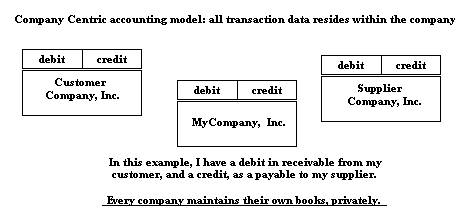
|
| Web applications - more of the same:
Debits equal Credits in my ledger.
- more CDEA.
- same benefits in internal bookkeeping
- no benefits in administering
external balances.
|
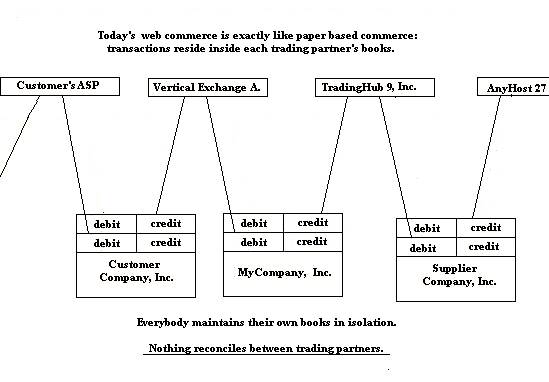
|
| Future, abstract:
Debits equal Credits within each trade, globally, among trading
partners.
- external balances are kept in
balance
- the root ledger of the
enterprise is not defined or constrained (legacy system can
continue.)
(This model is nuts
because the debits and credits that have floated up, are equal. See
the next frame.) |
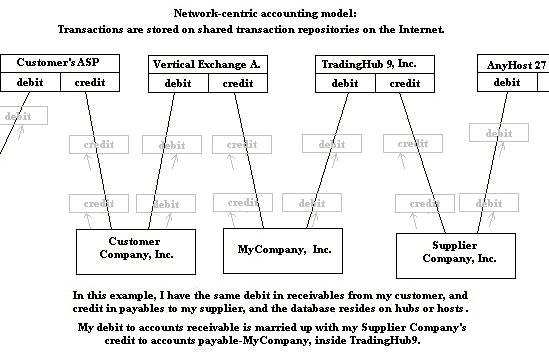 |
|
Single record of each trade, meeting
the needs of both trading partners symmetrically
- single entry
accounting
- works fine for consumers.
- general ledger is not provided
yet.
- but we have accomplished a good
thing: we have converged the AR and AP amount and date,
and description.
|
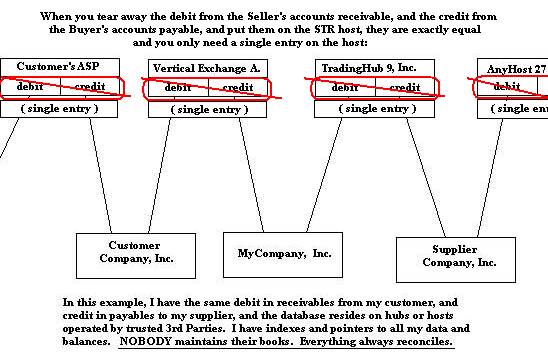 |
|
Future, STR model:
- ASPs and BSPs begin to provide persistent
storage
- You might call this NSEA - Network single entry
accounting. Only records of transaction events are
stored.
-
general ledgers may be maintained locally or on hosts or ASPs.
- combining of general ledgers
follows conventional consolidation methods.
- general ledgers may contain
replicas of STR entries, or just pointers.
|
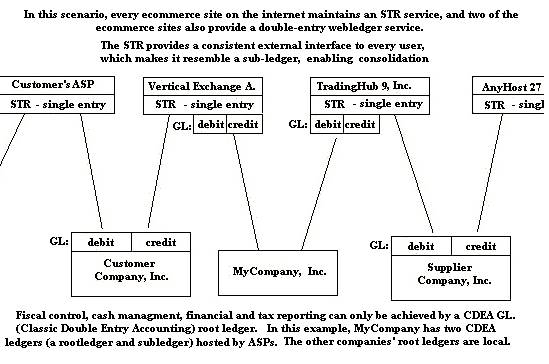 |
|
Future Scenario:
triple entry accounting
- ASPs and BSPs provide persistent STR structures
- Triple entry accounting. Records of transaction events are
stored, with private stub space, for party's use
-
The host is your general ledger, or sub-ledger.
- Your root ledger can contain
replicas of every transaction, or summary entries with pointers
and indexes.
|
 |
Note that in network-centric accounting,
- the pairs of debits and credits reside on hosts where
exchanges were mediated or transported, rather than inside the ledgers of the trading
partners.
- those pairs of debits and credits are not the same ones
that
would have been recorded inside the company-centric ledgers. There is
a debit from one party and a credit from the other.
- the pairs of debits and credits are
resolved into a single event record. The single record
contains the parties' identity, date, amount, and the consideration,
etc.
- each party donated a debit or a credit-- they
still need the other half of those CDEA entries.
Accordingly, STR is a triple-entry system providing a private stub for
each party's balancing entry. Most
businesses will continue to maintain classic double-entry ledgers as
in the past. But they don't have to: they can store those
on the servers, too, explained below.
But first, let's take a break, and get beat up by the small business
owner.
| |
"The objective of this architecture is to achieve the
simplest possible scheme for shared storage of transactions that
eliminates redundant storage, and eliminates any possibility of
inconsistency between the parties' records. " |
 |
 |
"Yeah right. I am going to store my
general ledger on your computer, on the internet? " |
|
| |
"No. You are going to store only
the date, amount, and description of your transaction
events on the internet,
encrypted so that only you and your trading partner can ever read
them. " |
 |
 |
"Why that's ridiculous. Why should I share any
of my data with my customer or supplier? " |
|
| |
"You already do. A snapshot of whatever you
bought or sold, or agreed upon, will be stored. Your
customer or supplier already stores the exact same information, internally.
Whatever you agreed upon is exactly the same information. " |
 |
Alternatives to consider:
A shared transaction repository could be achieved using any high-end multi-company
accounting system. You could record classic, double-entry accounting
(CDEA) transactions within such a ledger
for each party, just as intercompany transactions have been formed within
controlled groups, for the last 100 years. Consider this example
where Subsidiary A pays an expense for Subsidiary B thru "the
intercompany account".
General Ledger - Subsidiary
A
July 2000
JournalNo. Date LineNo.
Account
Amount
4441 22/7/2000 531
10100 Cash in Bank Cr
-400
4441 22/7/2000 532
19000 Interco Receivable Dr 400
...
.. |
General Ledger - Subsidiary
B
July 2000
JournalNo. Date LineNo.
Account
Amount
73821 2000/7/31
2355 525300 Vehicle Maint-NY
Dr 400
73821 2000/7/31
2355 250000 Interco Payable-NY
Cr -400
...
.. |
This is classic intercompany accounting. It could be done
today. Setup
any big midrange accounting package that has a browser interface such as
Great Plains or Lawson. Sell subscriptions to a bunch of
companies. Establish a separate company in the system for each subscriber.
Then, create business objects to post each transaction event that happens between
subscriber companies to
the appropriate ledgers. The intercompany payables and receivables would
always agree, whenever both parties to any transaction happen to be your
subscribers. Perhaps some companies having strong integration needs might
subscribe to your service, such as supply chain partners.
Multi-company CDEA ledgers don't work out of the
box, however, because
- they impose a number of unnecessary structures on the parties, and
constrain their choice of software to a common platform.
- the "trusted third party" has way too
much access to all of your data,
- the processing of external transactions is too tightly coupled, for
example, requiring locks on your tables when 3rd parties conduct
business with you, and
- a classic multi-company ledger model maintains much more information
than that data which is truly common to both trading
partners. Maintaining two CDEA ledgers goes far beyond what is strictly necessary to achieve the objective of the shared
repository; for one example, every company has different charts of
accounts and other attribute tables which don't need to be on a shared
host.
- Business process is way too complex. To create correct
double-entry postings to every unrelated company requires knowledge
that only exists inside the companies not on the ASP
- Computer processing for a whole midrange/ERP system
is too great. Doesn't scale due to hardware costs.
- It is far too difficult to add new companies, and
each new company requires too much system resources.
- The model has no hope of widespread adoption.
Accordingly, the design for this STR is simpler --it models
only the
event of the completion, or execution, of a transaction.
This model stores the amount and other attributes as they were
agreed by two
parties, and of course, stores them only once rather
than in two ledgers as would be done in a multi-company ledger.
Theoretical basis for an STR model:
Classic double entry accounting (CDEA) is an ingenious
modeling language, having template or solution for any possible
transaction. All accounting systems in use today are CDEA
--even the list-oriented personal finance programs have "splits" in
which you classify your cash or investment movements into income, expense,
transfers, etc.
CDEA entries for external transactions (i.e.
involving other parties) are the focus of the STR. Half of the
any bookkeeping entry for purchases or
sales represents the money exchange versus the reciprocal party. The
other half of the entry, generally,
represents your internal classification as income, expense, inventory, or other asset
or liability. STR is not concerned with these classifications other than
to support them, and recommend they be classified with XBRL types.
The external date and amount agreed with trading partner, owner, debtor or creditor with whom
the business transaction was concluded, has always been recorded identically in the other party's
books. This will be shared in the STR. We are not breaking
any new ground in law or business culture.
Any
modernization of CDEA for the web must provide data structures that serve the
needs of both parties to the transaction. Existing B2B XML messages contain such
structures--they are event-oriented, single entry
accounting entries which identify both parties, and contain a
transaction date, amount, and list the products or services.
The global economy may be viewed as a 3-dimensional cube containing sheets for every party in the
universe, summing to zero. (More discussion at GLschema1,
GLschema2). The money movements
of the entire economy are a single, multi-company ledger.







